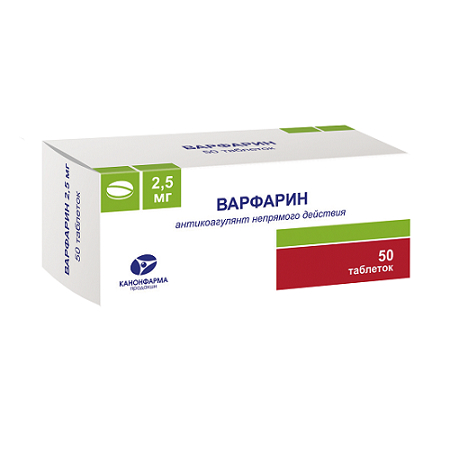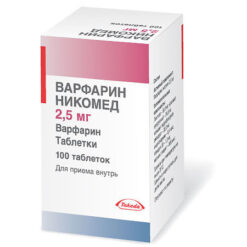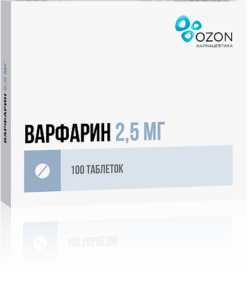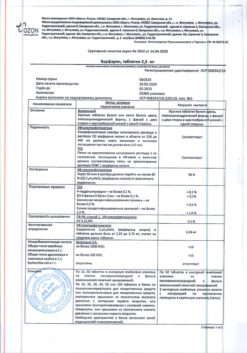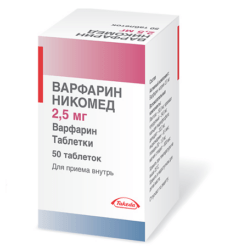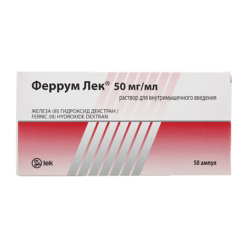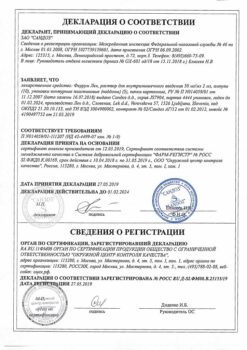No products in the cart.
Warfarin Canon, tablets 2.5mg 50 pcs
€1.00
Out of stock
(E-mail when Stock is available)
Description
Pharmacodynamics
Warfarin blocks in the liver the synthesis of vitamin K-dependent clotting factors (II, VII, IX, X), reduces their concentration in plasma and slows the clotting process.
The beginning of the anticoagulation action is observed 36-72 hours after the beginning of the drug administration with the development of the maximum effect on the 5th-7th day after the beginning of the drug administration. After discontinuation of the drug activity of vitamin K-dependent clotting factors is restored within 4-5 days.
Pharmacokinetics
The drug is quickly absorbed from the gastrointestinal tract almost completely. Binding to plasma proteins is 97-99%. It is metabolized in the liver.
Warfarin is a racemic mixture, with R- and S-isomers metabolized in the liver by different pathways. Each of the isomers is converted to 2 major metabolites.
The main metabolic catalyst for the S-enantiomer of warfarin is the enzyme CYP2C9 and for the R-enantiomer of warfarin CYP1A2 and CYP3A4. Left-handed warfarin isomer (S-warfarin) has 2-5 times greater anticoagulant activity than right-handed isomer (R-enantiomer), but T1/2 of the latter is longer. Patients with CYP2C9 enzyme polymorphism, including CYP2C9*2 and CYP2C9*3 alleles, may have increased sensitivity to warfarin and increased risk of bleeding.
Warfarin is excreted with the bile as inactive metabolites that are reabsorbed in the GI tract and excreted in the urine. T1/2 is 20 to 60 hours. For R-enantiomer T1/2 is from 37 to 89 hours, and for S-enantiomer from 21 to 43 hours.
Indications
Indications
Treatment and prevention of thrombosis and embolism of blood vessels:
Active ingredient
Active ingredient
Composition
Composition
1 tablet contains:
the active ingredient:
warfarin sodium 2.5 mg
How to take, the dosage
How to take, the dosage
Ingestion.1 time a day, preferably at the same time of the day.
The duration of treatment is determined by the doctor in accordance with the indications for use.
Control during treatment. MHO is determined before the start of therapy. Thereafter, laboratory monitoring is performed regularly every 4 to 8 weeks.
The duration of treatment depends on the clinical condition of the patient. The treatment can be discontinued immediately.
Patients who have not previously taken warfarin: The initial dose is 5 mg/day (2 tablets daily) for the first 4 days. On the 5th day of treatment, MHO is determined and the maintenance dose of the drug is prescribed according to this value. Usually the maintenance dose of the drug is 2.5-7.5 mg/day (1-3 tablets daily).
Patients who have previously taken warfarin: The recommended starting dose is twice the known maintenance dose of the drug and is prescribed for the first 2 days. Treatment is then continued with a known maintenance dose. On the 5th day of treatment, MHO is monitored and the dose is adjusted accordingly. It is recommended to maintain MHO index from 2 to 3 in case of prophylaxis and treatment of venous thrombosis, pulmonary embolism, atrial fibrillation, dilated cardiomyopathy, complicated heart valve disease, heart valve prosthesis with bioprosthesis. Higher MHOs of 2.5 to 3.5 are recommended for mechanical heart valve replacement and complicated acute myocardial infarction.
Children: There are limited data on the use of warfarin in children. The initial dose is usually 0.2 mg/kg/day in normal liver function and 0.1 mg/kg/day in impaired liver function. The maintenance dose is adjusted according to MHO levels. Recommended MHO levels are the same as in adults. The decision to prescribe warfarin and treatment monitoring in children should be made by an experienced pediatrician. Doses are adjusted according to the table below (Table 1).
Table 1
The selection of a maintenance dose of warfarin according to MHO values
Day 1If the baseline MHO value is 1 to 1.3, the shock dose is 0.2 mg/kg body weightDays 2 through 4 if the MHO value:Actions:1 to 1.3Repeat shock dose1.4 to 1.950% of shock dose2 to 350% of shock dose3.1 to 3.525% of shock dose>3.5Stop drug administration until MHO is achievedMaintenance if MHO value:Actions (weekly dose):1 to 1.3 Increase dose by 20% from 1.4 to 1.9 Increase dose by 10% from 2 to 3No change from 3.1 to 3.5Decrease dose by 10%>3.5Stop drug until MHO is achieved
Elderly people: there are no specific recommendations for taking warfarin in older people. However, elderly patients should be closely monitored as they have a higher risk of side effects.
Patients with hepatic impairment: impaired liver function increases the sensitivity to warfarin because the liver produces clotting factors and also metabolizes warfarin. Careful monitoring of MHO values is necessary in this group of patients.
Patients with renal impairment: Patients with renal impairment do not require any specific recommendations for warfarin dose selection. Patients on peritoneal dialysis do not need additional warfarin dose escalation.
Planning (elective) surgical interventions: pre-, peri- and postoperative anticoagulant therapy is performed as described below (if urgent withdrawal of oral anticoagulant treatment is necessary – see “Overdose. “Overdose”).
1. Determine MHO one week before the scheduled surgery.
2. discontinue warfarin 1-5 days before surgery. If there is a high risk of thrombosis, the patient is given low molecular weight heparin by injection for prophylaxis. The duration of warfarin pause depends on MHO. Warfarin is stopped:
– 5 days before surgery if MHO >4;
– 3 days before surgery if MHO is 3 to 4;
– 2 days before surgery if MHO is 2 to 3.
3. Determine MHO the evening before surgery and administer 0.5-1 mg of vitamin K1 orally or intravenously if MHO >1.8.
4. take into consideration the need for an infusion of unfractionated heparin or prophylactic low molecular weight heparin on the day of surgery.
5. Continue subcutaneous injection of low molecular weight heparin for 5-7 days after surgery with concomitant restored warfarin administration.
6. Continue warfarin administration from the usual maintenance dose on the same day in the evening after minor surgery and on the day the patient begins enteral feeding after major surgery.
Interaction
Interaction
It is not recommended to start or stop taking medications, or to change the doses of the taken drugs without consulting the attending physician.
In concomitant administration, the effects of cessation of induction and/or inhibition of warfarin action by other drugs should also be considered.
The risk of severe bleeding increases with concomitant use of warfarin with drugs that affect platelet levels and primary hemostasis: acetylsalicylic acid, clopidogrel, ticlopidine, dipyridamole, most NSAIDs (except COX-2 inhibitors), penicillin antibiotics in high doses.
You should also avoid concomitant use of warfarin with drugs that have a marked inhibitory effect on the cytochrome P450 system, such as cimetidine and chloramphenicol, which when taken for several days increases the risk of bleeding. In these cases, cimetidine may be replaced with, for example, ranitidine or famotidine.
The effect of warfarin may be increased if the following drugs are taken at the same time: acetylsalicylic acid, allopurinol, amiodarone, azapropazone, azithromycin, alpha- and beta-interferon, amitriptyline, bezafibrate, vitamin A, vitamin E, glibenclamide, glucagon, gemfibrozil, heparin, grepafloxacin, danazol dextropropoxyphene, diazoxide, digoxin, disopyramide, disulfiram, zafirlukast, indomethacin, ifosfamide, itraconazole, ketoconazole, clarithromycin, clofibrate, codeine, levamisole, lovastatin, metolazone, metotrexate, metronidazole, miconazole (includingÑ. oral gel), nalidixic acid, norfloxacin, ofloxacin, omeprazole, oxyphenbutazone, paracetamol (especially after 1-2 weeks of continuous use), paroxetine, piroxicam, proguanil, propafenone, propranololol, influenza vaccine, roxithromycin, sertraline, simvastatin, sulfafurazole, sulfamethoxazole, sulfamethoxazole-trimethoprim, sulfaphenazole, sulfinpyrazone, sulindac, steroid hormones (anabolic and/or androgenic) tamoxifen, tegafur, testosterone, tetracyclines, thienilic acid, tolmetin, trastuzumab, troglitazone, phenytoin, phenylbutazone, phenofibrate, feprazone, fluconazole, fluoxetine, fluorouracil, fluvastatin, fluvoxamine, flutamide, quinine, quinidine, chloral hydrate, chloramphenicol, celecoxib, cefamandole, cephalexin, cefmenoxime, cefmetazole, cefoperazone, cefuroxime, cimetidine, ciprofloxacin, cyclophosphamide, erythromycin, etoposide, ethanol.
Preparations of certain medicinal plants (official or unofficial) may also both enhance the effect of warfarin: e.g., ginkgo (Ginkgo biloba), garlic (Allium sativum), angelica sinensis, papaya (Carica papaya), sage (Salvia miltiorrhiza); and reduce: e.g., ginseng (Panax ginseng), St John’s wort (Hypericum perforatum).
Warfarin and any Hypericum preparations should not be taken simultaneously, and it should be taken into account that the effect of inducing the action of warfarin may persist for another 2 weeks after discontinuation of Hypericum preparations. If the patient takes St. John’s wort, MHO should be measured and administration should be discontinued. MHO should be monitored carefully, as MHO levels may rise if St. John’s wort is discontinued. Warfarin can then be prescribed.
The effects of warfarin may also be increased by quinine in tonic beverages.
Warfarin may increase the effect of oral hypoglycemic sulfonylurea derivatives.
The effect of warfarin may be impaired when concomitantly taken with the following drugs: azathioprine, aminoglutethimide barbiturates, valproic acid, vitamin C, vitamin K, glutethimide, griseofulvin, dicloxacillin, disopyramide, carbamazepine, colestyramine, coenzyme Q10, mercaptopurine mesalazine, mianserine, mitotane, nafcillin, primidone, retinoids, ritonavir, rifampicin, rofecoxib, spironolactone, sucralfate, trazodone, phenazone, chlordiazepoxide, chlorthalidone, cyclosporine. Administration of diuretics in case of marked hypovolemic effect may lead to increased concentration of clotting factors, which reduces the effect of anticoagulants. In case of concomitant use of warfarin with other drugs listed above, it is necessary to perform MHO control at the beginning and at the end of treatment, and, if possible, 2-3 weeks after the beginning of therapy.
Food rich in vitamin K weakens the effect of warfarin; decreased absorption of vitamin K caused by diarrhea or laxatives potentiates the effect of warfarin. Green vegetables contain the most vitamin K, so the following foods should be eaten with caution when treated with warfarin: Amaranth greens, avocados, broccoli sprouts, Brussels sprouts, cabbage, canola oil, chayo leaf, onions, coriander (cilantro), cucumber peels, chicory, kiwi fruit, lettuce, mint, green mustard, olive oil, parsley, peas, pistachios, red seaweed, spinach greens, spring onions, soybeans, tea leaves (but not drink tea), turnip greens, watercress.
Special Instructions
Special Instructions
It is mandatory for warfarin therapy that the patient adheres to the prescribed dose of the drug.
Patients with alcoholism and patients with dementia may not be able to adhere to the prescribed warfarin regimen.
Conditions such as fever, hyperthyroidism, decompensated heart failure, and alcoholism with concomitant liver damage may increase the effect of warfarin. In hypothyroidism, the effect of warfarin may be reduced. In case of renal failure or nephrotic syndrome, the level of free plasma fraction of warfarin increases, which, depending on the concomitant diseases, may lead to both enhancement and reduction of the effect. In cases of moderate hepatic impairment, the effect of warfarin is enhanced.
In all of the above conditions, careful monitoring of MHO levels should be performed.
Patients receiving warfarin should be prescribed paracetamol, tramadol or opioids as analgesics.
Patients with a mutation of the gene encoding the CYP2C9 enzyme have a longer T1/2 of warfarin. These patients require lower doses of the drug, because the normal therapeutic doses increase the risk of bleeding.
Do not take warfarin in patients with hereditary galactose intolerance, lactase enzyme deficiency, impaired glucose and galactose absorption. If rapid antithrombotic effect is necessary, it is recommended to start treatment with heparin administration; then combination therapy with heparin and warfarin should be carried out for 5-7 days until the target MHO level is maintained for 2 days.
In order to avoid coumarin necrosis, patients with hereditary antithrombic protein C or S deficiency should be given heparin first. The accompanying initial loading dose should not exceed 5 mg. Heparin administration should be continued for 5-7 days.
In cases of individual resistance to warfarin (very rare), 5 to 20 shock doses of warfarin are needed to achieve therapeutic effect. If warfarin administration is ineffective in such patients, other possible causes should be identified – concomitant administration of warfarin with other drugs, inadequate diet, laboratory errors.
The treatment of elderly patients should be carried out with special caution because the synthesis of clotting factors and hepatic metabolism in these patients is reduced, which may result in excessive effects of warfarin.
Contraindications
Contraindications
Side effects
Side effects
Very often (>1/10): bleeding.
Often (>1/100,
Infrequent (>1/1000,
Rarely (>1/10000,
Digestive system disorders: Vomiting, nausea, diarrhea.
Bleeding. Bleeding occurs in about 8% of patients receiving warfarin in one year. Of these, 1% are classified as severe (intracranial, retroperitoneal), leading to hospitalization or blood transfusion, and 0.25% as fatal. The most common risk factor for intracranial hemorrhage is untreated or uncontrolled hypertension.
The likelihood of bleeding is increased if MHO is well above the target level. If bleeding has started at an MHO that is within the target level, then there are other concomitant conditions that should be investigated.
Necroses. Coumarin necrosis is a rare complication of warfarin treatment. Necrosis usually begins with swelling and darkening of the skin of the lower extremities and buttocks or (less frequently) elsewhere. Later, the lesions become necrotic. In 90% of cases, necrosis develops in women. The lesions occur from day 3 to day 10 of the drug, and the etiology suggests a deficiency of antithrombic protein C or S. Congenital insufficiency of these proteins can be the cause of complications, so treatment with warfarin should be started with low initial doses and simultaneously with heparin administration. If a complication occurs, warfarin should be discontinued and heparin should be continued until the lesions are healed or scarred.
Pelvic skin syndrome. A very rare complication of warfarin therapy, its development is common in men with atherosclerotic disease. Warfarin is thought to cause hemorrhages in the area of atheromatous plaques, leading to microemboli. Symmetrical purpuric lesions of the skin of the fingers and soles of the feet, accompanied by burning pain, have been observed. After discontinuation of warfarin, these symptoms gradually disappear.
Others: hypersensitivity reactions manifested by skin rash and characterized by reversible increase in liver enzyme levels, cholestatic hepatitis, vasculitis, priapism, reversible alopecia and tracheal calcification.
Independent risk factors for serious bleeding when treated with warfarin include: older age, high intensity of concomitant anticoagulant and antiaggregant therapy, and a history of strokes and gastrointestinal bleeding.
The risk of bleeding is increased in patients with CYP2C9 gene polymorphism.
Overdose
Overdose
The treatment efficacy rate is on the border of bleeding development, so the patient may develop minor bleeding (e.g., microhematuria, bleeding gums, etc.).
Treatment: in mild cases – drug dose reduction or short-term treatment discontinuation; in minor bleeding – drug discontinuation until target MHO level is achieved. In case of severe bleeding – intravenous injection of vitamin K, administration of activated charcoal, clotting factor concentrate or fresh frozen plasma.
If oral anticoagulants are indicated for further administration, large doses of vitamin K should be avoided, as resistance to warfarin develops within 2 weeks.
Table 2
Treatment regimens for overdose
INR levelRecommendationsIn case of minor bleedingSkip the next dose of warfarin and continue lower doses when therapeutic MHO level is reachedSkip 1-2 doses of warfarin and continue lower doses when therapeutic MHO level is reached or skip 1 dose of warfarin and prescribe oral vitamin K at doses of 1-2.5 mggt;9Stop warfarin and administer vitamin K 3 to 5 mg orally5-9 (surgery to be performed)Stop warfarin and administer vitamin K 2 to 4 mg orally (24 hours before surgery to be performed)&20 or heavy bleedingVitamin K doses of 10 mg by slow IV infusion, transfusion of prothrombin complex factor concentrates or fresh frozen plasma, or whole blood. If necessary, repeat vitamin K administration every 12 hours.
After treatment, long-term follow-up of the patient is necessary, given that the T1/2 of warfarin is 20-60 h.
Pregnancy use
Pregnancy use
Warfarin quickly penetrates through the placenta, has teratogenic effects on the fetus (nasal hypoplasia and chondrodysplasia, optic atrophy, cataracts leading to complete or partial blindness, mental and physical developmental delays and microcephaly) at 6-12 weeks of pregnancy.
It may cause bleeding at the end of pregnancy and during delivery. The drug should not be administered in the first trimester of pregnancy and during the last 4 weeks. Use of warfarin is not recommended in other periods of pregnancy unless absolutely necessary.
Warfarin is excreted with breast milk in unmeasured amounts and does not affect the clotting activity of the breast-fed baby. Warfarin can be used during lactation.
Additional information
| Shelf life | 2 years |
|---|---|
| Conditions of storage | In a dry, light-protected place at a temperature not exceeding 25 °C |
| Manufacturer | Kanonfarma Production ZAO, Russia |
| Medication form | pills |
| Brand | Kanonfarma Production ZAO |
Other forms…
Related products
Buy Warfarin Canon, tablets 2.5mg 50 pcs with delivery to USA, UK, Europe and over 120 other countries.

